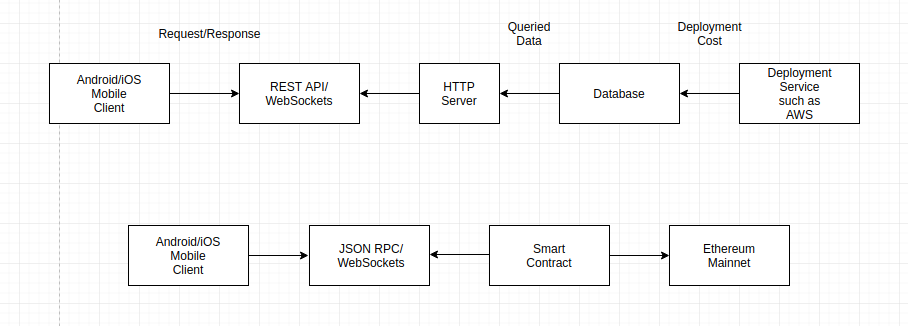Heard of Web 3.0? It is a phase where all connected networks, including the likes of blockchains will be able to interact and access data seamlessly with one another while upholding security and user experience.
Right now, there is major challenge. Two different blockchains cannot talk to one another. In the smart contract world, this is even more apparent. DApps (decentralized applications) being developed on the Ethereum blockchain can’t seem to access external data due to the ethereum protocol itself.
Blockchain interoperability is key for the survival of blockchain technology especially for smart contract technology because the need to interact and connect with external networks to access data for smart contracts Dapps to truly be accepted by the masses is essential.
However, there is a way to circumvent this and it has got to do with ‘oracles’. (No! Not the old man with a crystal globe. It’s something else 🙂
Data Inaccessible Outside Blockchains
Oracles are code connecting a blockchain with the real world. They provide the data that smart contracts need in order to execute successfully. To undestand how ‘oracles’ work, lets first try to understand how smart contracts work (briefly).

A smart contract is a self-executing contract with the terms of the agreement between buyer and seller being directly written into lines of code. The code and the agreements contained therein exist across a distributed, decentralized blockchain network. The code controls the execution, and transactions are trackable and irreversible.
Smart contracts permit trusted transactions and agreements to be carried out among disparate, anonymous parties without the need for a central authority, legal system, or external enforcement mechanism.
But here is the challenge – A blockchain smart contract is unable to to access data outside of its network. The only this can be done is if the information is manually fed into the chain, else there is no way a smart contract blockchain can pull data outside of its perimeter.
Here is where oracles come in.
How Oracles Work?
Blockchain data is deterministic, meaning it has a sequence. Normal data is non-deterministic, meaning there’s no mechanism that proves the order by which the data was created. With oracles, smart contracts will be able to access data from the outside of its network. This can be achieved through several approaches.
One, by using big data applications or Internet of Things (IoT). Various data aspects can be accessed with this approach such as weather forecasts, payments, crop health, etc
However, there are several other types of oracles which cater to different data aspects.
For example:-
- Software oracles – ability to process data from online sources.
- Outbound oracles – ability to give smart contracts permission to send data to the outside world.
But eventhough the possibilities of having use oracles can be endless, there are several challenges to using it right now. For example, how can you trust the outside data source?
Orcales, by design are not subjected to the same security protocols as found in blockchain protocols they are assigned to work with. Circumventing this aspect requires strong second layer implementations. However, the possibilities are endless but there is still a lot of work to be done.
RIF Gateways
One of the ways to work around this security and trust challenge is to use RIF Gateways.
RIF Gateways ar basically a set of interoperability protocols designed to give tamper-proof and work in a secure manner when dealing with external sources. This works when the oracle is sitting in a versatile interface layer which unified the concepts of cross-chain integrations.
Benefits of Using RIF Gateways
One main advantage of using RIF is the sureity of maintaining a ‘protocols agnostic approach’. Meaning, when it comes to the different blockchain stacks accessing data, RIF Gateways make sure the data aspects being accessed is never at the peril of blockchain security.
Not only does RIF Gateways can ensure data integrity, it can also conform to various other industry solutions and standards, without compromising the user experience.
A working example of how RIF Gateway works can be seen in RSK Technology’s work on what they’ve done to bridge the gap between RSK smart contract platform with Bitcoin’s blockchain platform. They achieved this via using RIF Gateway, which is part of the RIF OS, a third layer versatile interface based on the RSK’s technology.
 Oracle Projects In The Works
Oracle Projects In The Works
There are several initiatives of oracles being carried out by a few companies. One of them is ChainLink. (https://chain.link/)
What ChainLink does is it gives smart contracts secure access to data feeds, APIs and payments. To promote the work and get the word out, they financially reward developers who report on accurate data and those who help spread the information amongst many different computers.
Augur is another oracle project which basically does a similar thing as Chainlink but for the prediction markets predicting the future and thoughts on market sentiment.
Do you know of any other oracle projects out there? Share in the comments section below.
In a previous article, I shared my believe in the vision of interoperable enterprise blockchains and how they rest on five key technical ingredients.
Video
Quickly learn about what are Oracles and their importance in building decentralized applications and smart contracts.
Image: Szilárd Szabó from Pixabay
Video: By Hashoshi
- Ooki DAO Seeks Legal Defence against CFTC Drawing on Community Support - September 30, 2022
- MetaMask’s New Beta Portfolio dApp to Provide All-In-One Access to Cryptos, NFTs - September 30, 2022
- Bitcoin’s Bullish Seasonality Muddled by Continued Slide in ‘USD Liquidity Index’ - September 30, 2022



You should check out QED, the Oracle to rule them all. QED is a decentralised Oracle protocol with a robust economic model connecting multiple blockchains, smart contract platforms and off-chain data sources. For more information check out https://qed.network